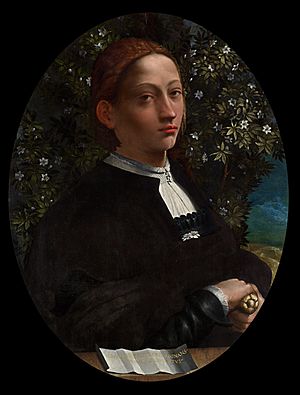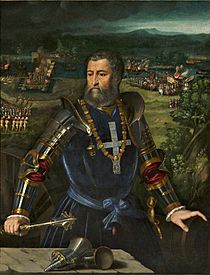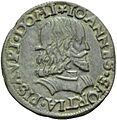Lucrezia Borgia facts for kids
Quick facts for kids Lucrezia Borgia |
|
|---|---|
| Duchess of Bisceglie Princess of Salerno Countess of Cotignola |
|

Possible Lucrezia portrait painted from life (attributed to Dosso Dossi, c. 1519, National Gallery of Victoria)
|
|
| Duchess consort of Ferrara, Modena and Reggio | |
| Tenure | 25 January 1505 – 24 June 1519 |
| Lady consort of Pesaro and Gradara | |
| Tenure | 12 June 1493 – 20 December 1497 |
| Born | 18 April 1480 Subiaco, Papal States |
| Died | 24 June 1519 (aged 39) Ferrara, Duchy of Ferrara |
| Burial | Convent of Corpus Domini |
| Spouse |
Giovanni Sforza
(m. 1493; annulled 1497) |
| Issue Detail |
Rodrigo of Aragon Ercole II d'Este, Duke of Ferrara Ippolito d'Este Eleonora d'Este Francesco d'Este, Marquis of Massalombarda |
| House | Borgia |
| Father | Pope Alexander VI |
| Mother | Vannozza dei Cattanei |
Lucrezia Borgia (born April 18, 1480 – died June 24, 1519) was an important Italian noblewoman. She was the daughter of Pope Alexander VI and Vannozza dei Cattanei. Lucrezia was known for her intelligence and beauty.
Her family arranged several marriages for her. These marriages helped her family gain more political power. Her husbands included Giovanni Sforza, Alfonso of Aragon, and Alfonso I d'Este. Alfonso of Aragon was the son of the King of Naples. It was rumored that Lucrezia's brother, Cesare Borgia, might have been involved in his death when his political importance to the family changed.
Some stories portray Lucrezia as a mysterious and powerful woman. She has been shown in many artworks, books, and movies.
Contents
Lucrezia Borgia's Early Life
Lucrezia Borgia was born on April 18, 1480, in Subiaco, near Rome. Her mother, Vannozza dei Cattanei, was one of the mistresses of Lucrezia's father. Her father was Cardinal Rodrigo de Borgia, who later became Pope Alexander VI.
Lucrezia's education was managed by Adriana Orsini de Milan. She was a close friend of Lucrezia's father. Lucrezia learned about the Humanities, which was a popular area of study at the time. She was very well-educated for a woman of her era.
She could speak Spanish, Catalan, Italian, and French fluently. She also knew Latin and Greek. Lucrezia was good at playing the lute, writing poetry, and public speaking. She was also skilled in managing important tasks. Later in life, she handled official letters for the Vatican City and helped govern Ferrara.
Lucrezia Borgia's Marriages
Lucrezia Borgia had three important marriages. Each marriage was arranged by her family to help their political goals.
First Marriage: Giovanni Sforza

In 1491, Lucrezia was first engaged to Don Cherubino Joan de Centelles. This engagement was quickly canceled. Then she was engaged to Don Gaspare Aversa.
When her father became Pope Alexander VI, he wanted to connect with powerful Italian families. So, he canceled Lucrezia's earlier engagements. He arranged for her to marry Giovanni Sforza. Giovanni was a member of the House of Sforza. He was the Lord of Pesaro. They married on June 12, 1493, in Rome.
After some time, the Borgia family no longer needed the Sforzas as much. The Pope wanted new political connections. It is believed that Lucrezia's brother, Cesare Borgia, warned her that her husband might be in danger. Giovanni then quickly left Rome.
The Pope asked Giovanni's uncle, Cardinal Ascanio Sforza, to convince Giovanni to agree to end the marriage. Giovanni first refused. But he was offered his dowry (money or property brought by a bride to her husband) back. The Sforza family also threatened to stop protecting him if he did not agree. Giovanni finally signed the papers to annul the marriage.
Second Marriage: Alfonso of Aragon

After her first marriage ended, Lucrezia married Alfonso of Aragon. He was from Naples. They married in 1498. This made Lucrezia the Duchess of Bisceglie and Princess of Salerno.
Lucrezia was made governor of Spoleto in 1499. This was a position usually held by cardinals. Alfonso left Rome shortly after this. But he came back when Lucrezia asked him to. He died in 1500.
Many people believed that Lucrezia's brother Cesare was responsible for Alfonso's death. This was because Cesare had recently formed an alliance with France against Naples. Lucrezia and Alfonso had one child, Rodrigo of Aragon. Rodrigo was born in 1499 and passed away in August 1512, at the age of 12.
Third Marriage: Alfonso d'Este
After her second husband died, Lucrezia's father arranged her third marriage. She married Alfonso I d'Este, the Duke of Ferrara. They married in early 1502 in Ferrara.
Lucrezia had several children during this marriage. She became a respected and successful duchess of the Renaissance. She managed to overcome her earlier reputation. She also survived the decline of the Borgia family after her father's death.
On June 14, 1519, Lucrezia gave birth to her tenth child, Isabella Maria. The baby was very weak. Lucrezia became very ill after the birth. She seemed to get better for two days, but then she worsened. She passed away on June 24, 1519. She was buried in the convent of Corpus Domini.
Lucrezia Borgia's Appearance
Lucrezia was described as having long, blonde hair that reached past her knees. She had a beautiful complexion and hazel eyes that seemed to change color. People said she had a full, high chest and a natural grace. She was said to "walk on air." These features were highly valued in Italy during that time.
Another description mentioned that "her mouth is rather large, the teeth brilliantly white, her neck is slender and fair, and the bust is admirably proportioned."
A painting called Portrait of a Youth by Dosso Dossi might be a portrait of Lucrezia. It is at the National Gallery of Victoria. This painting might be the only formal portrait of Lucrezia Borgia that still exists. However, some experts are not sure if it is really her. Other paintings, like one by Bartolomeo Veneto, have also been said to show her. But scholars have not confirmed any of them yet.
According to Mandell Creighton, a historian, Lucrezia was popular because of her beauty and friendly nature. He wrote that her "long golden hair, her sweet childish face, her pleasant expression and her graceful ways, seem to have struck all who saw her."
Lucrezia Borgia's Children
Lucrezia was the mother of several children:
- A miscarriage or stillborn daughter (February 16, 1499)
- Rodrigo of Aragon (November 1, 1499 – August 1512), son by Alfonso of Aragon.
- A stillborn daughter (1502), her first child with Alfonso d'Este.
- Alessandro d'Este (1505–1505).
- Ercole II d'Este, Duke of Ferrara (April 5, 1508 – October 3, 1559).
- Ippolito II d'Este (August 25, 1509 – December 1, 1572). He became an Archbishop and later a Cardinal.
- Alessandro d'Este (1514–1516).
- Leonora d'Este (July 3, 1515 – July 15, 1575). She was a nun and a composer.
- Francesco d'Este, Marquess of Massalombarda (November 1, 1516 – February 2, 1578).
- Isabella Maria d'Este (born and died on June 14, 1519). Lucrezia passed away ten days later due to complications from this birth.
Images for kids
-
Tomb of Alfonso I d'Este and Lucrezia Borgia, Ferrara
See also
 In Spanish: Lucrecia Borgia para niños
In Spanish: Lucrecia Borgia para niños
- Castello Borgia
- Felice della Rovere
- Route of the Borgias






